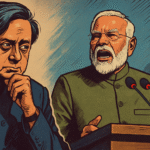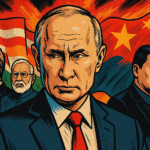Once upon a time in India, making videos for the internet was seen as a hobby, a distraction, or something you did after quitting your engineering dreams. Fast forward to today, and digital creators are raking in crores, influencing over $350 billion in annual consumer spending, and turning smartphones into studios and Instagram reels into income streams.
According to a recent report by the Boston Consulting Group (BCG) titled ‘From Content to Commerce: Mapping India’s Creator Economy’, India’s creator ecosystem isn’t just booming—it’s on track to explode. We’re talking about a projected growth to $1 trillion by 2030. Yes, you read that right. That’s trillion with a T.
- Once upon a time in India, making videos for the internet was seen as a hobby, a distraction, or something you did after quitting your engineering dreams. Fast forward to today, and digital creators are raking in crores, influencing over $350 billion in annual consumer spending, and turning smartphones into studios and Instagram reels into income streams.
- 1. Who Are These Creators and Why Are They So Powerful?
- 2. The Money Game: From Filters to Fortune
- 3. Why Brands Can’t Ignore the ‘Reel’ Power
- 4. The Content That Clicks: It’s Not All Glitz & Glam
- 5. Challenges: Not All That Glitters Is Sponsored
- 6. What the Future Looks Like (Spoiler: It’s Bright & Buzzing)
- 7. Final Thoughts: Should You Become a Creator Too?
Let’s break it down, shall we? And in a way that even your favorite meme page admin would approve of.
1. Who Are These Creators and Why Are They So Powerful?
Creators are no longer just influencers showing off OOTDs or lip-syncing to movie dialogues. They are educators, entertainers, entrepreneurs, and everyday people with Wi-Fi and a point of view. BCG defines creators as individuals with more than 1,000 followers—a club now 2 to 2.5 million strong in India.
From financial advisors explaining stocks in street-style rap to 16-year-olds reviewing gadgets in perfect Hinglish, these creators are shaping what we buy, believe, and binge.
Why? Because trust has shifted. Audiences now rely more on creators than traditional celebrities or brand campaigns. They’re relatable, raw, and refreshingly real. And when they say, “Buy this face wash,” Gen Z listens—not because of endorsements, but because it feels like advice from a friend.
2. The Money Game: From Filters to Fortune
BCG’s report suggests that direct revenue from creators is expected to skyrocket from $20–25 billion today to $100–125 billion by 2030. But here’s the plot twist—only 8–10% of creators currently monetize effectively.
Which means there’s a massive pot of digital gold waiting to be discovered. And no, you don’t need a viral dance video or a Bollywood hookup to access it. You just need strategy, consistency, and a little understanding of how this creator economy actually works.
Monetization isn’t just about brand deals anymore. It includes:
- Affiliate marketing
- Subscriptions
- Merchandise
- Digital courses
- Virtual gifting
- E-commerce tie-ups
- And yes—sponsored posts (the OG method)
So the next time someone says, “Creators toh sirf Reels banate hain,” remind them that those 15 seconds can be worth thousands of rupees if done right.
3. Why Brands Can’t Ignore the ‘Reel’ Power
Imagine spending crores on a TV commercial that half your audience skips. Now imagine paying a creator a fraction of that amount for a video that gets more views, more comments, and better engagement.
That’s why creator marketing is becoming central to brand strategy. BCG notes that budgets for creator partnerships are likely to grow by 1.5 to 3 times in the next 2–3 years. Brands are no longer dipping their toes—they’re doing cannonballs into the influencer pool.
And why not? It’s cost-effective, fast, and delivers better ROI. But here’s the catch: creators now demand more than just a one-off deal. They want long-term partnerships, creative freedom, and mutual respect. It’s less “collab” and more “co-creation.”
4. The Content That Clicks: It’s Not All Glitz & Glam
What kind of content rules this roost? Short-form video is king. Think:
- YouTube Shorts
- Instagram Reels
- Moj
- Josh
- Snapchat Spotlight
The content itself spans a vast range—comedy, education, finance, fashion, daily soaps (yes, really), gaming, and even gharelu jugaads. Basically, if it can be recorded, captioned, and posted, it can make money.
This isn’t just entertainment; it’s influence. And brands are waking up to the power of creators from tier-2 and tier-3 cities, whose reach and relatability often outperform big-city influencers.
5. Challenges: Not All That Glitters Is Sponsored
But let’s not pretend this is a perfect fairy tale. Behind the filters are creators battling:
- Burnout from algorithm changes
- Trolls and toxicity
- Payment delays
- Platform dependency
- Mental health issues
- Uncertain income streams
Plus, monetization models in India are still maturing. Platforms, creators, and advertisers are figuring things out in real time. Which means while the opportunities are vast, the rules are still being written.
6. What the Future Looks Like (Spoiler: It’s Bright & Buzzing)
BCG’s report predicts that by 2030, creators will influence 25–30% of India’s total consumer spend. That’s mind-blowing.
This means:
- More creator-owned brands
- Greater adoption of AI tools for content creation
- Rise of vernacular and hyperlocal content
- Increased use of data to measure performance
- More creator training schools and agencies
Simply put, we’re entering a phase where creators aren’t just internet sensations—they’re businesses. Some are already building teams, managing payrolls, and launching their own IPs.
7. Final Thoughts: Should You Become a Creator Too?
Why not?
If you’ve got a story, skill, or sense of humor, the internet is your playground. The creator economy doesn’t need perfection—it craves authenticity.
But before you quit your 9–5 and start vlogging from your balcony, remember: it’s a grind. Content creation is a full-time hustle, not a shortcut to fame. It takes resilience, reinvention, and a deep connection with your audience.
Still, the opportunity is real. And for those who get it right, the rewards aren’t just in followers or funds—they’re in freedom.
TL;DR:
- India’s creator economy is booming, heading toward $1 trillion by 2030.
- Creators now influence over $350 billion in annual spending.
- Only 8–10% monetize well today—huge growth ahead.
- Brands are increasingly relying on creators over traditional ads.
- Short-form video and vernacular content are driving the trend.
- The future belongs to creators who are consistent, creative, and community-driven.
So next time your mom asks why you’re talking to your phone again, just tell her:
“Maa, main creator ban raha hoon—economy ka future hoon.”












